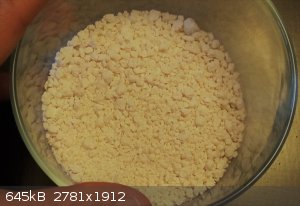palico
Hazard to Self
 
Posts: 59
Registered: 1-10-2013
Member Is Offline
Mood: No Mood
|
|
Synthesis of calcium acetate from eggshells
Hello people,
today I present the preparation of calcium acetate from eggshells and vinegar.
The reaction is a simple acid-base between acetic acid and calcium carbonate, which eggshells are made of.

Procedure
100 g of eggshells are washed well with water and ground into tiny pieces. These are introduced into a large glass jar. To this, 1.5 l of 6% vinegar
is added. Suddenly, a vigorous reaction occurs, with strong gas production and foam, controlled by swirling and with a glass rod.
Once the effervescence is slowed down, another 0.5 l of vinegar is added. The jar is left standing at room temperature for two days with occasional
swirling. At the end, the reaction mixture is filtered through a cotton plug, the filtrate evaporates off to half volume on an open flame, and the
remaining is poured into a casserole and evaporated to dryness: an off-white jelly is obtained. The crude jelly is treated with 200 ml of acetone to
remove water and acid residual, filtered through a cotton plug; the residue is pressed on paper and left to dry in the open air.
109 g of white solid is obtained, corresponding to 61.87% yield, considering eggshells as pure calcium carbonate.

To watch the full procedure, I link you to my YT video
Thanks for attention, see you next time
palico
|
|
|
Admagistr
Hazard to Others
  
Posts: 350
Registered: 4-11-2021
Location: Central Europe
Member Is Offline
Mood: The dreaming alchemist
|
|
Hi, nice work. You probably just used vinegar that's tinted brown. At least here in Europe, they sell vinegar like that. The color probably comes from
the caramel. To get a purer product, it would be better to pre-distill the vinegar before reacting. Or recrystallize the acetate.
I see in the video that your vinegar is colorless, so the color of the acetate must be coming from the carotene? in the shells.
[Edited on 6-1-2024 by Admagistr]
|
|
|
BerkutSimp
Harmless

Posts: 2
Registered: 23-12-2023
Location: Toronto, Ontario
Member Is Offline
Mood: Excited to finally be here
|
|
Quote: Originally posted by palico  | Hello people,
today I present the preparation of calcium acetate from eggshells and vinegar.
The reaction is a simple acid-base between acetic acid and calcium carbonate, which eggshells are made of.
Procedure
100 g of eggshells are washed well with water and ground into tiny pieces. These are introduced into a large glass jar. To this, 1.5 l of 6% vinegar
is added. Suddenly, a vigorous reaction occurs, with strong gas production and foam, controlled by swirling and with a glass rod.
Once the effervescence is slowed down, another 0.5 l of vinegar is added. The jar is left standing at room temperature for two days with occasional
swirling. At the end, the reaction mixture is filtered through a cotton plug, the filtrate evaporates off to half volume on an open flame, and the
remaining is poured into a casserole and evaporated to dryness: an off-white jelly is obtained. The crude jelly is treated with 200 ml of acetone to
remove water and acid residual, filtered through a cotton plug; the residue is pressed on paper and left to dry in the open air.
109 g of white solid is obtained, corresponding to 61.87% yield, considering eggshells as pure calcium carbonate.
To watch the full procedure, I link you to my YT video
Thanks for attention, see you next time
palico |
I believe you can buy vinegar concentrate for better results I'm guessing because it'll have a higher concentration of acetic acid
|
|
|
Sulaiman
International Hazard
    
Posts: 3561
Registered: 8-2-2015
Location: 3rd rock from the sun
Member Is Offline
|
|
Nice experiment and writeup
A suggestion for a later experiment..
If you have the equipment for it,
you could heat the calcium acetate to decompose it
and condense the acetone that is released by the decomposition,
the other product being calcium carbonate.
Convert vinegar to acetone!
Of course using acetone to dry the calcium acetate would be counterproductive,
unless you also recover it.
Acetone and water do not form an azeotrope so distillation will separate them reasonably well due to wide bp difference
and fractional distillation should give good separation
- if you don't blow yourself up!
PS I've only read about it - not tried.
CAUTION : Hobby Chemist, not Professional or even Amateur
|
|
|
Rainwater
National Hazard
   
Posts: 800
Registered: 22-12-2021
Member Is Offline
Mood: indisposition to activity
|
|
Awesome production quality.
If you pyrolysis the eggs before the reaction, that will remove a lot of the organic contamination
"You can't do that" - challenge accepted
|
|
|
palico
Hazard to Self
 
Posts: 59
Registered: 1-10-2013
Member Is Offline
Mood: No Mood
|
|
Dear guys, thanks a lot for comment. The product is perfectly white, just the photo is low quality.
@Admagistr: actually the vinegar used is perfectly colorless, as you can see from video. On label, is said to be " alcohol vinegar ", so probably is
not vinegar but just an acetic acid solution of synthetic origin. Magic of discount supermarket.
@sulaiman: Yes, I know the synthesis of acetone by pyrolysis of calcium acetate. Once I collect more, I will do it.
|
|
|